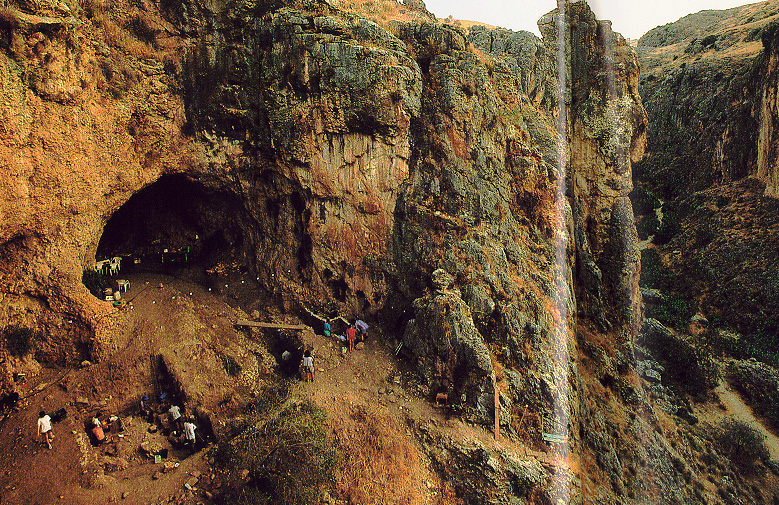EXAMPLE of a simple expert system to identify 20Kroner, 5Kroner and 1Kroner Norwegian coins.

The first step is to identify the variables-
SIZE / COLOUR / DECORATION
Then assign a range of values for each variable-
SIZE
diameter is >25mm
diameter is <25mm
COLOUR
silver
bronze
DECORATION
head
crown
ship
lion
Then rules are constructed that identify the coins by combinations of attributes (attributes are the particular value of a variable e.g., a coin can have the attribute of being silver in colour, or decorated with a lion).
RULES:
IF SIZE > 25 and COLOUR is bronze and DECORATION is ship THEN coin is 20K
IF SIZE < 25 and COLOUR is silver and DECORATION is crown THEN coin is 1K
IF SIZE >25 and COLOUR is silver and DECORATION is lion THEN coin is 5K
These rules can be simplified to extract the distinguishing features of the coins (or stone tool types in LITHAN or tool function in FAST).
IF SIZE > 25 and COLOUR is bronze THEN coin is 20K
IF SIZE < 25 and COLOUR is silver THEN coin is 1K
IF SIZE >25 and COLOUR is silver THEN coin is 5K
When dealing with incomplete specimens which have missing attributes, 'fuzzy logic' is employed in order to make probability statements. (see fuzzy logic).
IF SIZE > 25 THEN add 1 into coinA
IF SIZE < 25 THEN add 1 into coinB
IF COLOUR is bronze THEN add 1 into coinA
IF COLOUR is silver THEN add 1 into coinB
IF DECORATION is ship THEN add 1 into coinA
IF DECORATION is crown THEN add 1 into coinB
From these 'scores' fuzzy logic probabilities can be assigned-
IF coinA = 3 Then coin is a 20Kroner (fuzzy logic probability of 1)
IF coinB = 3 Then coin is a 1Kroner (fuzzy logic probability of 1)
IF coinA = 2 Then coin is PROBABLY a 20Kroner (fuzzy logic probability of 0.7)
IF coinB = 2 Then coin is PROBABLY a 1Kroner (fuzzy logic probability of 0.7)
Fuzzy logic probabilities are not employed in LITHAN because tool types are based on mutually exclusive categories, but are used in FAST because use wear features often overlap and are therefore not mutually exclusive categories.
see Use-wear analysis.
The first major advantage of using an expert system for lithic analysis is the act of writing it. "The process of developing an expert system has an indirect benefit also since the knowledge of human experts must be put into an explicit form for entering in the computer. Because the knowledge is then explicitly known instead of being implicit in the expert's mind, it can be examined for correctness, consistency and completeness. The knowledge may then have to be adjusted or re-examined which improves the quality of the knowledge." (Giarratano and Riley 1989, 5).
The expert system approach is essentially looking for patterns in complex dynamic phenomena that have proved to be beyond standard quantification techniques. For example 'ship decoration' (see above) cannot be quantified. The outcome of the expert system is a probability statement concerning the tool type or function that is most consistent with the observations. The interpretations are made according to the balance of indications given by the expert system rules and based on the observation of all features.
Expert systems are not intended to replace human experts. For example, the recognition of retouch on stone tools as opposed to edge damage (from spontaneous retouch, trampling, post depositional movement, etc.), is dependent on the analyst's experience and in particular on experimentation, involving not only observation of experimental and archaeological tools , but also an appreciation of the mechanics of making and using stone tools.
Expert systems ensure that interpretations are consistent and comply with the tenets of scientific method. For example, one definition of scientific schemes describes such expert systems, "... scientific schemes are explicit i.e., the rules and the way they are to be applied are spelled out with sufficient clarity and in enough detail that they can be used by anyone. ... such a set of rules can be encoded in a computer program... " (Casti 1993,29).
The expertise gained over many years of research is made available to less experienced practitioners. One of the features of expert systems is that, "The expert system may act as an intelligent tutor by letting the student run sample programs and explaining the system's reasoning." (Giarratano and Riley 1989,5). As an expert system models the behavior of an expert (hence the name), the incorporation of such expert systems into teaching programs enables students to understand the reasoning processes of the expert rather than simply learning the outcome of the reasoning. As the rules that operate the expert system are derived from a number of sources the expertise of many researchers is incorporated into the program. The LITHAN and FAST programs are currently being used as part of a teaching program for lithic analysis.
The use of expert systems has a number of advantages over other techniques.
Increased consistency and standardisation. The development of an expert system means that the observational techniques have to be systematised and the rules provide a base from which results can be assessed.
Different analysts using the same program will obtain the same results. This has been repeatedly confirmed during instruction in use-wear analysis when several students have independently analysed the same experimental tools and all interpreted the correct function of the tool using FAST. Often students enter different observations, due to inexperience, but the flexibility of the program (in particular the 'fuzzy logic' aspects) allows for this so that some variations in observations can be accommodated.
Analysts working on different material can use the same program. As demonstrated in a recent study of lithic material from Tehuacán and Oaxaca in Mexico which involved using local material in replication experiments (Hardy 1993)
The rules and procedures for expert systems can be continually being updated in order to improve and refine the analytical procedures. For example, since the FAST program has been in use in Norway (Ballin & Jensen 1995) a large number of experiments have been carried out on fish. The information gained from these experiments has been incorporated into the rules of the FAST expert system making the identification of fish processing more accurate. Subsequently these new rules have helped in identifying fish processing during current research on Neanderthal associated material from Amud cave, Israel.

The use of rule based expert systems is a practical approach to lithic studies that bridges the gap between processual and post processual archaeology. The key here is rules; not laws which are inviolate, but rules that can be changed and indeed are always changing in a reflexive relationship allowing the expert system to accommodate new information.
The rules of the expert system are subjective, but they are explicit in that they are written down and incorporated into the computer program. The observations are defined and the rules are explicit therefore anyone can produce the same results, so that though the system is subjective it is consistent when different subjectivities (i.e. different individuals) use it. The acceptance of the assumptions on which the program is based leads to consistency, and direct comparability between results produced by different people; this fulfills the basic requirements of objective data within the consensus reality of mutual users of the program. Therefore expert systems can extract objective-like data, but the complexity of the dynamic process is retained and the data is produced in the form of probabilities that can be compared as if they are objective data within a defined consensus reality.
Expert systems are so called because they are designed to model the behaviour of a human expert. So they are modeling human behaviour, in fact an individuals behaviour. By extension expert systems can be used to model the more complex behaviour of societies. A series of programs that input the results of each individual program into another program further up the hierarchy is being developed. Not only must the interpretations be consistent with use-wear analysis and lithic programs, but non-lithic material such as the faunal assemblage, environmental evidence and spatial information from the site and any chronological evidence.
Alternative interpretations can be modeled with expert systems so rather than postulating a theory and then testing it, a number of alternatives can be tested and matched against the data simultaneously.
“an expert system is a computer program which uses non-numerical domain-specific knowledge to solve problems with a competence comparable with that of human experts" (Doran 1988).
"The process of developing an expert system has an indirect benefit also since the knowledge of human experts must be put into an explicit form for entering in the computer. Because the knowledge is then explicitly known instead of being implicit in the expert's mind, it can be examined for correctness, consistency and completeness. The knowledge may then have to be adjusted or re-examined which improves the quality of the knowledge." (Giarratano and Riley 1989, 5).
For technical descriptions of the Lithan (lithic analysis) and FAST (Functional Analysis of Stone Tools) expert systems see
Interpreting the Function of Stone Tools by Roger Grace published as an ebook by
